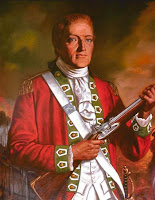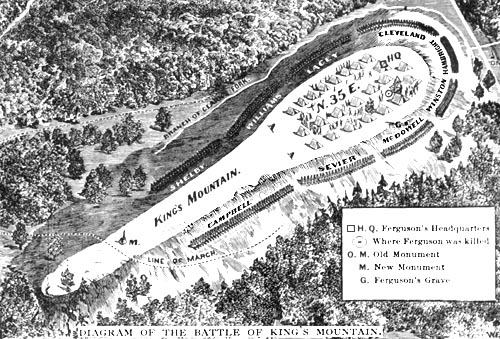Colonel Benjamin Cleveland was of the same bold character as Daniel Boone and found his most delightful pleasure in hunting rather than plowing. As a young man he was often found in the woods hunting and gathering pelts.
Two of his childhood friends were Thomas Sumter and Joseph Martin. Sumter would later be known as the “Gamecock” in the struggle for freedom in South Carolina. Martin would become the Indian agent for the fledgling new nation trying to curtail the Cherokee uprisings caused by the British in the back country.
Cleveland trekked off to Kentucky after
hearing Daniel Boone talk with great admiration of the hunting lands. He and his friends were robbed by Indians and sent packing on foot, back to the
Watauga region around Wilkes County, NC.
After recuperating from his journey he marched back over the
mountains to retrieve the horses from the very Indians that had stolen
them. In a show-down with the main suspect Indian,
Cleveland narrowly escapes a tomahawk and a gunshot from the enraged guilty
party. He was able to ride away with
the property reacquired and a feather in his cap of self-confidence.(1)
Cleveland would brag that his ancestor was the Oliver
Cromwell who was renowned for his leadership of England. Benjamin owned a copy of "The Life and Adventures of Mr. Cromwell, Natural
Son of Oliver Cromwell” and would point to it when making this claim.(2) If one can speak of something and thereby
cause it to be, simply by applied belief, then it is probable Benjamin
Cleveland identified with the "bigger than life" persona of Oliver Cromwell. Cleveland’s
intrepid spirit certainly was as bold as Cromwell; or at least the character of
the biography, Cromwell’s son. At close to six feet in height and weighing
in at a solid 300lbs of big muscle, few would wish to dispute Cleveland's force of
nature.
Cleveland’s men were brutal and
confident. Ever portraying an aura of
wildness, some would wear Scottish Tartans and Kilts that they had taken off dead
Highland Scot Tories at the Battle of Moore’s Bridge in 1776.(3) They were rough men who mirrored the
personality of their leader and were known to the Tories as “Cleveland’s Devils”.(4)
During the Revolution, Benjamin Cleveland was busy running about the upcountry of North Carolina with his men chasing Tories. It was in the midst of this action when the call went out from Isaac Shelby and John Sevier to rally and meet Major Ferguson’s threats head on.
During the Revolution, Benjamin Cleveland was busy running about the upcountry of North Carolina with his men chasing Tories. It was in the midst of this action when the call went out from Isaac Shelby and John Sevier to rally and meet Major Ferguson’s threats head on.
Prior to the Battle of King’s
Mountain, Cleveland made an impassioned speech to his men who understood life and death in their extremities. Matter of fact in its delivery, it spoke to the unfettered resolve of the men under his command. “My brave fellows! We have beat the Tories before, and can beat
them again. They are all cowardly. If they had the spirit of men they would have
joined your fellow citizens in supporting the Independence of this Country. When engaged, you are not to wait for the
word of command from me. I will show you
how by my example on how to fight. I can
undertake no more. Everyman must consider
himself an officer, and act on their own judgement. Fire as quick as you can, and stand as long
as you can without tiring. When you can
do no better, get behind a tree or retreat.
I beg you not to run away, but if you do make it a point to return to
battle as quickly as possible, and renew the fight.”(5)
Born and raised into a mindset of independence and self reliance, he bravely fought his way in and out of battle. His exploits reverberate in Freedom's call even today. He was a feared and revered and was one of the heroes of King's Mountain.
After the war he moved to Oconee County, SC and is buried on private property near Westminister, SC off of Hwy 123. In the Madison community, close to the Savannah River, an obelisk bearing his name can be found near the Madison Baptist Church. (6)
Freedom Reigns!
Born and raised into a mindset of independence and self reliance, he bravely fought his way in and out of battle. His exploits reverberate in Freedom's call even today. He was a feared and revered and was one of the heroes of King's Mountain.
After the war he moved to Oconee County, SC and is buried on private property near Westminister, SC off of Hwy 123. In the Madison community, close to the Savannah River, an obelisk bearing his name can be found near the Madison Baptist Church. (6)
Freedom Reigns!
(1) Before They Were Heroes at
King’s Mountain, Randell Jones
(2) http://www.ibiblio.org/mtnivy/BAJ/crouch.htm
(3) Ghosts of Yadkin Valley,
R.G. Absher
(4) http://colbenjaminclevelandchapter.org/colonel-benjamin-cleveland/
(5) https://www.josephmartinchapter.org/smartin.html
(6) https://www.findagrave.com/memorial/31176869/benjamin-cleveland
(6) https://www.findagrave.com/memorial/31176869/benjamin-cleveland












